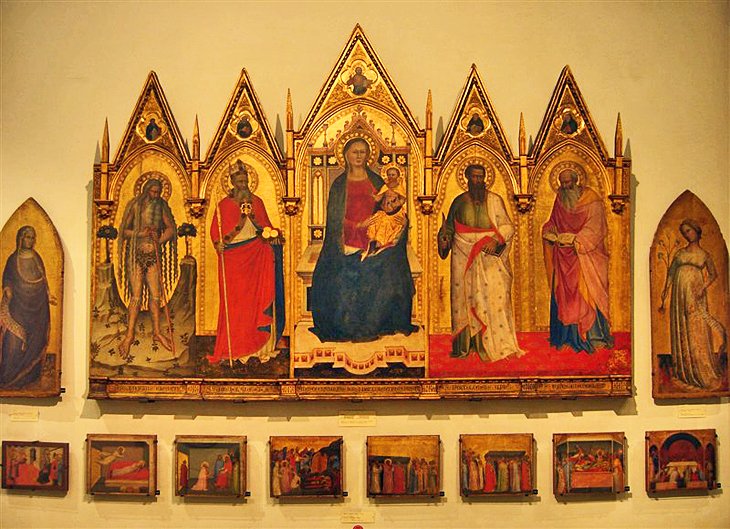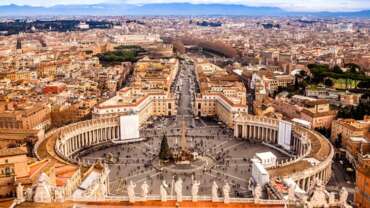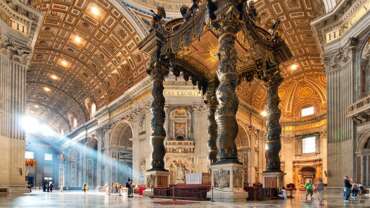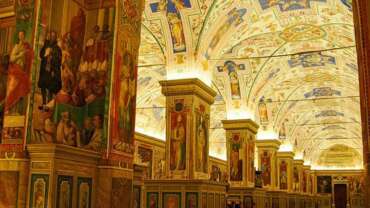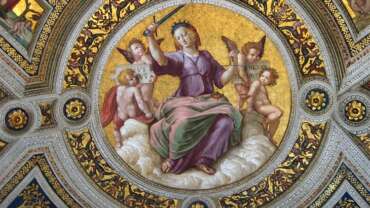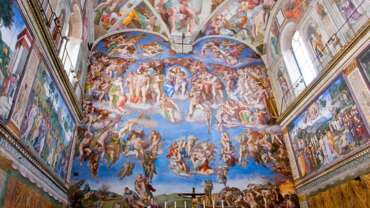Experiences in Vatican City
Pinacoteca (Picture Gallery)
Even though it was robbed of many of its treasures by Napoleon, the Pinacoteca contains 16 rooms of priceless art from the Middle Ages to contemporary works. Arranged in chronological order, the pictures give an excellent survey of the development of Western painting. Medieval art includes Byzantine, Sienese, Umbrian, and Tuscan paintings, as well as a Giotto triptych and a Madonna and St. Nicholas of Bari by Fra Angelico. There is a triptych by Filippo Lippi, Coronation of the Virgin by Pinturicchio, and a Madonna by Perugino. A room is devoted to tapestries from cartoons by Raphael; his Madonna of Foligno; and his last painting, the famous 1517 Transfiguration. Portraits include da Vinci’s unfinished St. Jerome, a Titian Madonna, and Caravaggio’s Entombment.
Museo Pio Clementino
The Vatican Museums have the largest collection of ancient sculpture in the world, mainly found in Rome and the surrounding areas, most of it displayed in the systematic arrangement designed by Popes Clement XIV and Pius VI from 1769 to 1799. These galleries contain such a wealth of magnificent and significant pieces that even a list of the highlights is a long one. In the Sala a Croce Greca, don’t miss the red porphyry sarcophagi of Constantine’s daughter, Constantia, and his mother, St. Helen, both richly decorated with figures and symbols. In the Sala delle Muse look for Belvedere Torso, a first-century-BC work by Apollonius of Athens that was admired by Michelangelo. In the Gabinetto delle Maschere is a mosaic floor of theatrical masks from the Villa Adriana in Tivoli. In the Cortile del Belvedere is one of the most famous statues in the Vatican – the Apollo Belvedere. In the Galleria delle Statue notice the Candelabri Barberini,the finest ancient candelabras known, also from the Villa Adriana at Tivoli. Galleria dei Busti contains, along with lunette frescoes by Pinturicchio, the celebrated Laocoön group, a masterpiece of Hellenistic sculpture showing the Trojan priest Laocoön and his sons in a mortal struggle with two huge snakes.
Vatican Necropolis
Beneath the grand dome and priceless frescoes of St. Peter’s, a treasure trove of archaeological finds awaits. Many are aware of the papal grottoes just beneath the cathedral where former Popes have been entombed in private chapels, and the 12th-century church that accompanies them. What some don’t know is that there are extensive ruins, which have been excavated even deeper in the earth below, revealing burial grounds from as early as the 1st century BCE. The deepest of the three levels contains a pagan burial site, and the next level up contains both pagan and Christian graves, as well as ruins including stone crypts and arches dating through the 5th century. The most significant discovery, however, is a gravesite believed to contain the remains of Saint Peter himself, a relic that the Vatican continues to excavate with painstaking care.
Vatican Gardens
The first parts of the Vatican Gardens were created for Pope Nicholas II in the 13th century, meant to be a space for peaceful reflection. Over the centuries, the landscaped gardens, grassy spaces, and orchards have grown to cover nearly one-half of the area of the tiny city-state and rival the most beautiful gardens in Italy. In addition to the formal French Garden, visitors will find many individually potted plants along the paths, which contain stunning azaleas and other lush flowers. Planted among these and in the orchard are several rare trees, including an Australian silk-oak, as well as many trees that were brought as gifts by official visitors. Perhaps the most significant of these trees is the olive tree, which was presented by the State of Israel to symbolize peaceful relations with the head of the Catholic Church. Tours in the garden must be arranged in advance through the Vatican Museum.
Etruscan Museum
The Etruscan Museum, founded by Pope Gregory XVI in the mid-19th century, has 18 rooms of artifacts, which shed new light on the life of the Etruscans and their idea of the afterlife. Among the findings from the Etruscan graves that have been excavated throughout Tuscany are not just funerary items, but art works and objects from the everyday life of these enigmatic people. Particularly outstanding are the grave goods found in the Regolini-Galassi tomb at Cerveteri, the Mars of Todi, a head of Athena, and a number of very fine Etruscan vases.
Egyptian Museum
The Egyptian Museum in the Cortile della Pigna was re-founded in 1839 by Pope Gregory XVI, the first collection having been assembled earlier by Pius VIII. Much of the collection was brought from the Villa Adriana in Tivoli, where they had been collected by the Emperor Hadrian. Supplementing Hadrian’s collections are artifacts assembled by 19th-century collectors. The compilation here isn’t large, but its nine rooms exhibit some fine examples of Egyptian art from the third millennium to the sixth century BC. Highlights include basalt and wooden sarcophagi, sculptures of gods and pharaohs, bronzes, mummified heads, stelae with hieroglyphic inscriptions, statues of gods and animals, and papyri. In the last two rooms, you’ll find art from ancient Mesopotamia, vases and bronzes from Syria, and reliefs from Assyrian palaces.
Museo Chiaramonti
The Museo Chiaramonti, founded by Pope Pius VII in the early 19th century, is housed in a long gallery leading to the Papal palace and in the Braccio Nuovo. Concentrating on works of Greek and Roman art, the museum includes a number of Roman copies of earlier works by some of the most famous Greek sculptors, the only record of them that survives. Among the highlights of the thousand-odd sculptures, friezes, and reliefs are the Augustus of Prima Porta, a statue of the emperor found in the villa of his wife Livia; a statue of the god of the Nile; and Spear Carrier, a copy of the work by Polycletus. In the Sala della Biga, near the entrance, are two Discus Throwers, copies of fifth-century-BC works. A funeral monument of a miller dating from the first century was found at Ostia, and two splendid gilded bronze peacocks are thought to have come from Hadrian’s Mausoleum.



